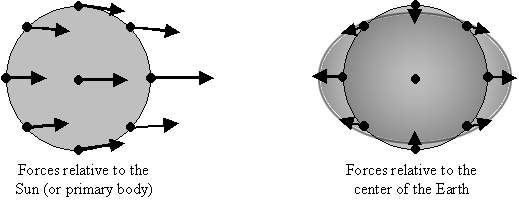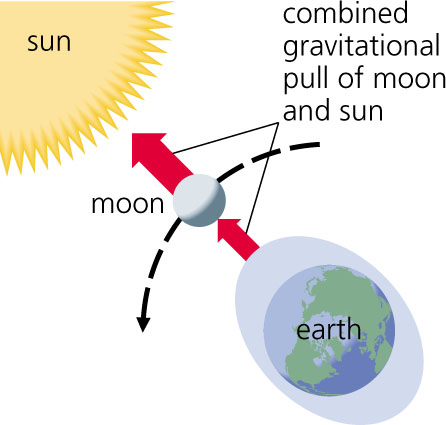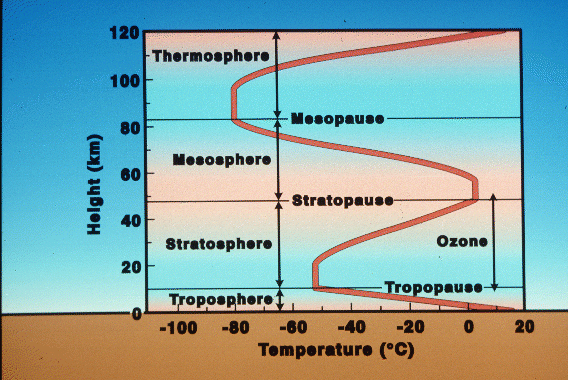| Physics 202 |
Intro to Astronomy: Lecture #9a
|
Prof. Dale E. Gary
NJIT
|
The Earth-Moon System
The Tides
It may seem that on Earth we should
feel the same gravitational force from the Sun anywhere on Earth, but in fact
at noon we are 13,000 km closer to the Sun than near midnight when we are
on the other side of the Earth. This 13,000 km may seem a small difference
compared to the 150 million km distance from the Sun, but even so the difference
has consequences. These
differences in the force experienced within a body lead to tidal
bulges, as shown in Figure 2, below.

Figure 2: Differential
(tidal) forces on a body relative to the primary (left), and relative to
its
own center (right). The
forces relative to its center stretch the body along the line joining the
body and the primary, and compress
the body along the perpendicular directions, to form a
football shape (prolate spheroid).
The figure on the left shows the
forces relative to the Sun, and the figure on the right (obtained by subtracting
the central force on the left from all of them) shows the forces relative
to the center of the body. These relative forces tend to stretch the
body laterally, and compress the body in the perpendicular direction, to form
a football shape. In the case of Earth, the liquid oceans are easily disorted
into the above shape, so that the oceans become slightly deeper in the direction
both toward and away from the Sun--about 1 meter in the deep oceans. However,
the Earth is rotating under these tidal bulges, and the water can slosh much
higher in some areas such as the St. Lawrence Seaway. As
the Earth rotates, the continents pass through these tidal bulges once a day,
causing the diurnal tides every 12 hours.
Both the Moon and the Sun exert
tidal forces on the Earth. Although the Moon is much smaller than the
Sun, it is also much closer. In fact, the Sun's influence is only 5/16 of
the total, while the Moon causes 11/16 of the total influence. So
the Moon exerts more than twice the influence as
the Sun, but the Sun-produced tides are still significant. When
the Sun and the Moon line up (near new or full Moon), the forces add together
and cause very high spring tides (the
word spring is not related to the season!). When the Sun is 90 degrees
from the Moon (near first and third quarter), the high and low tides are not
as great--these are called neap tides.
|

|

|
|
Spring
Tide
|
Neap
Tide
|
Consequences of Tidal Friction
The ocean tides are not
the only effect of these tidal forces. The solid body of the Earth also
bulges slightly in this way. The daily flexing of the Earth (both solid
body and sloshing of the oceans) cause loss of energy of the Earth's rotation,
due to friction. This energy goes into heat, increasing the Earth's internal
temperature. The loss of rotational energy means that the Earth is slowing
down in its rotation rate, currently by about 0.002 seconds per century.
As you might imagine, the Earth
also exerts tidal forces on the Moon. In fact, the tidal forces of Earth
on the Moon are about
20 times larger than those from the Moon on the Earth. Note what happens
when a rotating body is tidally distorted. The line of distortion is
continually being rotated away from the line between the two bodies, causing
the bulges to lead slightly. There is then a net torque opposing the
direction of rotation, thus slowing down both bodies. This torque exists
until the slowing rotation causes the body's orbital period to equal its rotational
period. Once this happens, the body is said to be tidally
locked, and the torque and dissipation by tidal forces ceases.
At this moment in time, the Moon is tidally locked with the Earth, but the
Earth is not tidally locked with the Moon. That is why the Moon keeps
the same face to the Earth. In the distant
future, the slowing Earth will eventually become tidally locked with the Moon,
and no further evolution of the system will occur.
When this occurs, what will the
Earth/Moon system look like? The leading bulge of the Earth also exerts
an extra pull on the Moon in its orbit, giving a slight acceleration along
the orbit, and increases its orbital velocity. This means the Moon
is slowly spiraling away from the Earth.
Lecture Quiz
#1
Atmospheres
The atmosphere
is the layer of gas that surrounds some planets. As you may know, heating
a gas causes it to expand (the pressure increases). A massive planet like
Jupiter has such a strong gravity that it can hold down its gases, and they
cannot escape into space. Earth can hold on to heavier gases, like oxygen
and carbon dioxide, but not the lightest gases such as hydrogen and helium.
Any body has an escape speed, which is
how fast an object has to move in order to escape. The escape speed at Earth's
surface is 11.2 km/s. When a gas is heated, its particles move faster, so
whether a gas will be kept in Earth's atmosphere depends on how hot it is,
and whether the molecules are moving faster than the escape speed. But not
all gas molecules move at the same speed. We talk about the average speed,
which depends on the temperature, but even when most molecules are moving
at a lower average speed, a few of the fastest will still exceed the escape
speed and drift off into space. The closer the average speed is to the escape
speed, the more molecules are lost, and the faster the atmosphere will escape.
Moon
Does the Moon
have an atmosphere? To find out, we compare the escape speed of the Moon
with the speed of the gas particles making
up its atmosphere. Unless the gas particles are moving a lot (a factor
of 10) slower than the escape speed, the particles will seep out of the atmosphere
over time. The Moon's escape speed is only 2.32 km/s, and the speed of
oxygen (02) at the Moon's surface is 0.78 km/s.
So
the escape speed is only 3 times the average speed. The Moon will lose
any oxygen that might be produced, after only a few hundred years.
Any atoms
lingering around the Moon, produced due to outgassing or spalation from rocks,
lasts only for a short time and must be continually replenished. The
atmosphere of the Moon is an amazingly good vacuum, only 10-14
atm.
Earth
When the Earth
was first formed, its atmosphere would have started out to be mostly H and He,
but lost it due to the speed of these particles allowing them to escape over
time. A new, heavier atmosphere of H2O,
O2, N2, and
CO2 was outgassed from volcanism, or brought
here by comets.
The pressure
of the Earth's atmosphere (and all atmospheres) fall
with height, so by far most of the atmosphere is at the lowest heights. The
temperature also falls with height, at least near the surface. That is why
it gets so cold and there is so little air at the top of a mountain.
This same general behavior is true for all atmospheres, even the atmospheres
of stars! But notice what happens in the figure below, which shows a plot
of the change of temperature with height in the Earth's atmosphere.
Atmospheric temperature
structure:

Why does
the temperature of the atmosphere drop to a height of about 10 km, then start
to rise again in the Stratosphere? This is due to absorption of ultraviolet
(UV) light from the Sun, which deposits energy in this region of the atmosphere,
and heats it. This region is called the Stratosphere because it is stable
to upward motions (an inversion layer), which means that clouds do not rise
in columns, but spread out in thin layers, like strata. The region of
maximum heating by UV light (the Stratopause) is also the location of the
ozone layer, O3, which is largely responsible for absorbing
the UV and protecting us from the harmful radiation.
Up to the
Mesopause, the temperature again declines, but then rises again in the Thermosphere
due to absorption of X-rays from the Sun. This "atmosphere" is only
slightly below the height of low Earth orbiting satellites such as the Space
Shuttle, which orbits about 200 km up, and this part of the atmosphere is
so thin that it is a nearly perfect vacuum.
The Earth's
atmosphere is about 1/5 O2,
and 4/5 N2, with trace amounts of other gases
such as carbon dioxide (CO2)
and water (H2O).
However, the amount of
CO2
has risen significantly in the last 200 years, partly as a result of human
activity (burning fossil fuels, etc.). Carbon
dioxide is a greenhouse
gas, so-called because it acts like a greenhouse in keeping the
Earth warm. How
does the greenhouse effect work? Radiation from the Sun passes through the
atmosphere in the visible range of the spectrum, and heats up the ground,
which then reradiates the energy out into
space, but now in the infrared part of
the spectrum. Greenhouse gases block the escape of the heat by absorbing the
infrared radiation. As a result, there
are alarming indications that the Earth's climate is getting warmer. The Earth's
climate has gotten colder and warmer at intervals over time, causing glacial
periods and interglacial periods, so it is impossible yet to tell whether
humans are mainly to blame for the climate warming. Nevertheless, we can
help to keep the problem under control by reducing greenhouse gas emissions.
Lecture
Question #2
Interiors
The
Earth is the one planet that we can study in great detail. We know a lot
about the structure of the interior of the Earth, but we must remember that
other planets may be different in fundamental ways. We must take what
we learn about Earth and compare and contrast it with the other planets.
The mean
or bulk density
of a planet is an easily measured quantity that can tell us a great deal about
what the planet is made of. Earth's bulk density is 5520
kg/m3
(compare with
the density of water, 1000 kg/m3).
But the density of the Earth's surface (density of silicate rocks) is only 2800
kg/m3, so the interior
must be much more dense than the surface. The structure of the interior
of the Earth has been pieced together from a number of clues, such as what the
surface is made of, what we see coming to the surface in volcanoes, and most
of all what we learn from earthquakes.
The earthquakes,
adjustments of the Earth's crust due to internal stresses, launch two types
of seismic waves, longitudinal compression
(P) waves (sound waves), and transverse
distortion (S) waves. The P waves travel
faster, and so the letter P could stand for Pressure or Prompt waves.
The slower S waves arrive later, and so the letter S could stand for Secondary,
or Slow waves. An important difference between longitudinal and transverse
waves is that longitudinal waves can travel through liquid, but transverse
waves cannot. Both kinds of waves refract
due to density gradients in the Earth's interior. Due to the refraction
of both kinds of waves, and the lack of propagation of S waves, we learn that
the interior has a liquid layer, and also can measure such quantities as temperature
and density as a function of depth. See this
web page to see some drawings of the interior of the Earth. If you
ever wondered how Earthquake epicenters and magnitudes are determined, take
this short virtual
earthquake lesson.
The Moon's
interior is quite different from the Earth's. From seismic experiments left
from the Moon landings, we know that the
Moon appears to be made entirely of the crustal material of the same sort
as Earth's surface. It is strange that it does not have metals in its
core. It is thought that late in the formation of the Earth, a giant
impactor (planetesimal) struck the Earth. Such a collision would have
destroyed the impactor, the metals of the impactor would sink to the center
of the Earth, and much of the outer crust of the Earth could have been torn
off to later come together to form the Moon. This may explain the unusually
thin crust of the Earth's oceans. Without the impact, the Earth might
not have plate tectonics, as we discuss in the next section.
Lecture Quiz
#3
Surfaces
Earth
The surface
of the Earth is dominated by plate tectonics. The idea of plate tectonics
explains the shape of the continents, the locations of earthquake zones and
volcanoes, the locations of mountains and ocean trenches, the presence of
hotspots such as Hawaii and Yellowstone, and many other phenomena. For many
years the subject was hotly debated, but in the 1970's it was finally widely
accepted and has revolutionized our understanding of the Earth's surface.
The other
great factor in shaping the Earth's surface, of course, is weathering by water,
ice, wind, and the action of plants and animals. Over geologic time, mountains
are worn down and craters are obliterated, even while new ones are created
through continental drift and asteroid strikes.
Moon
The surface
of the Moon, on the other hand is dominated by craters, highlands (mountainous
areas), and maria (low-lying lava-filled depressions). Like many other planets,
the Moon is heavily cratered. However, most craters are more than 4 billion
years old, indicating that the heavy bombardment by asteroids and planetesimals
ceased by about then. The Earth must also have been similarly pocked by craters,
but weathering obliterated them. The oldest rock on Earth's surface is now
only about 3.5 billion years.
Some time
after the bombardment ceased, lava welled up into the lower basins to create
the maria (latin for seas, although they have nothing to do with water). Since
the Moon keeps the same face to Earth, humankind did not know what the other
side of the Moon looked like until space probes were launched to orbit the
Moon in the 1960's. What we found is that the far
side of the Moon is not like the near side.
Lecture Quiz
#4
Earth's Magnetic
Fields (Magnetosphere)
The
rotating liquid metallic core of the Earth generates magnetic fields that, at
the surface, look like a dipole (a North and South magnetic pole). At
the surface of the Earth, the magnetic field strength is about 0.4 gauss.
This is the magnetic field that allows a compass to point north. The magnetic
fields reach far out into space, and surround the Earth in a protective region
called the magnetosphere.
Some other planets have a magnetosphere also, especially Jupiter.
Disturbances of the magnetosphere
by the Sun cause the aurorae,
or northern (and southern) lights, as well as many other effects. We will
talk more about this when we discuss solar activity.



